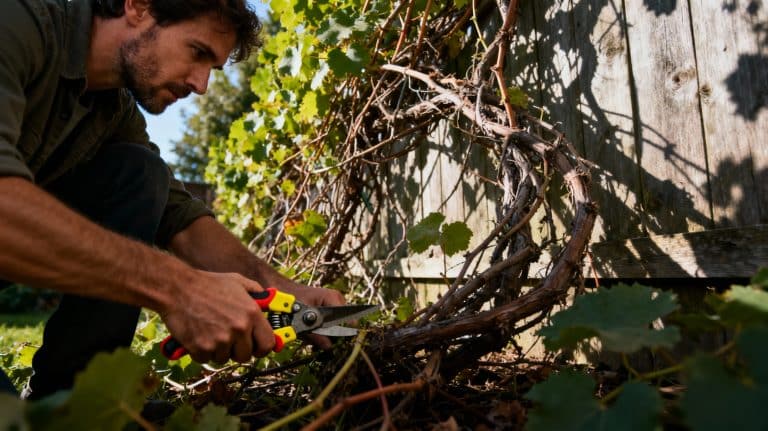Patience pays off in the garden; you can overcome grape vines for good. If you’ve tried cutting them and watching them return, you’re not alone.
Start by cutting every vine at ground level and laying the ends down to prevent climbing or feeding. Leave vines attached to fences or trees for now; pulling them risks damaging things you want to keep.
You’ll notice wiry canes and sticky tendrils gripping your fence; that’s today’s battle, but not yet the war.
Right Now: Cut Every Vine at Soil Level, Pause Regrowth
-
Cut every vine stem at or just above soil level. Leave the top growth hanging in place for now.
-
Clear a 2-3 foot circle around each cut stem so you can see and access the stump later.
-
Mark each stump with a flag or stake. Grapes love to hide under mulch and leaf litter.
-
If you’re not treating today, cover each cut stump with a dark can or cup to block light and pause regrowth for a few days.
Cutting vs Killing Grape Vines, and Why Vinegar Fails
Cutting only hides grape vines temporarily; true killing stops roots from resprouting. Vinegar merely burns the leaves but never affects the roots. Our focus is on eliminating grape vines at the root.
1. Cut Stump Method: The Most Permanent Way to Kill Grape Vines
The “cut stump” method is the gold standard because it moves the kill down into the root system, not just the leaves.
-
Tools like hand pruners or a saw, a small disposable brush or foam applicator, and a concentrated brush killer with either glyphosate or triclopyr. A couple drops of blue marking dye helps you see coverage.
-
Make a fresh cut across the stump as close to the soil as you can. You want a clean, moist surface.
-
Immediately within a few minutes paint herbicide onto the cut surface. Wet the entire face, especially the outer ring just under the bark where transport tissues live. Don’t spray. Paint it on to avoid drift.
-
Avoid getting any herbicide on the bark of nearby trees, shrubs, or roots you want to keep by using the baggie method. Wear gloves and eye protection. Follow the label.
You’ll see early wins as leaves on connected canes lose shine and slump within 24-48 hours. Good sign within 5-7 days: canes brown out and you don’t see a flush of new shoots from the base.
Note on timing: Fall is best (late September-November in most regions), when vines are pulling sugars and anything on that cut surface back to the roots. You can still treat in spring/summer it works but fall often takes fewer follow ups.
2. Dig Out the Root System for Chemical Free Removal
If you want a herbicide free solution, you can evict a vine by removing its roots. Cut the stem, then start your trench about 2-3 feet out from the stump and work inward.
Follow the biggest roots with a shovel, mattock, or root saw, prying out as much as you can find. Expect a long, knuckly network that can run for yards. Any chunk left with a bud can resprout, so patience here pays off.
The upside: when you’ve traced and removed the major roots, you’re truly done. If you’ve won, you’ll notice no new sprouts over the next several weeks.
3. Smother the Stump and Root Zone for 12–18 Months
Cut the vine at ground level, then cover the stump and a 3-4 foot circle with thick, light proof material heavy black plastic, old rubber roofing, or a layered tarp. Edge it with bricks or pins so zero light leaks through.
Keep it in place for 12-18 months. That long, yes: you’re starving a big battery underground. You’ll see pale, weak shoots trying to find light at the edges early on. Keep tucking and re-securing until the attempts stop.
Why Grape Vines Keep Coming Back, Energy in Roots
Grapes are perennial vines that hoard energy in large, woody roots. Cutting the top is like cutting the power cord to your lamp, not the breaker. The root wakes up, spends its savings, and pushes up new shoots.
That’s why your earlier cuts looked great for a week and then…green everywhere. The two reliable paths to “permanent” are: deliver a lethal dose to the transport tissue when the plant is moving sugars to the roots (cut and treat), or remove those storage roots (digging). Everything else is just tiring it out, which can work if you’re relentless for seasons as with lasting bindweed control.
Best Timing to Kill Grape Vines, Fall After First Frost
-
Best window for cut and treat: fall, when nights cool and leaves are still attached. Aim for after the first light frost and before hard freeze in colder regions. In warm climates, target late fall when growth slows.
-
Spring and summer still work if you treat immediately after cutting. You may just need a follow up on any new shoots.
-
Deep winter: you can cut, but herbicide moves slowly in dormancy. If you treat then, expect a spring touch up.
Two Quick Checks, Scratch Test and Regrowth Watch
-
Scratch test: nick a cane. Bright green and moist means active. Treat now will move well.
-
Regrowth watch: after any method, scan weekly. The first tiny shoots are easiest to kill flick them off or dab them with herbicide right away.
Keep Grape Vines From Returning, Monthly Patrol
Once the big vines are gone, prevention is boring and that’s the point. Walk the area monthly in growing season. If you see a new grape seedling or a shoot from a missed root, remove it that day.
Don’t compost viable cuttings. Bag and trash them or let them dry to tinder before disposal. Where vines were feeding from neighbor edges or wild borders, create a 3-4 foot mulch strip you keep weed free. Grapes hate repeated disturbance. Consistent little wins stop the next takeover.
If you removed vines from a fence, consider a low, solid barrier at the base (landscape edging set 6-8 inches deep) to make future shoots obvious and easy to clip. Replanting with dense groundcovers is another option: you’ll still patrol, but sunlight competition helps keep grape seedlings from getting established.
Grape Vines on Trees, Fences, and Buildings, Safe Removal
Don’t pull. Grapes cling hard and can peel bark, pop fence panels, and yank shingles. Cut at the base and a second time shoulder high so you know what’s dead above you.
Let the upper growth dry and loosen for a season. Then it peels off in lighter, safer sections. Around desirable trees, keep herbicide off bark and exposed roots paint only the grape’s cut surface. Where vines have crept into siding or soffits, cut and let them die back before any gentle removal.
A few safety notes you’ll be glad you followed: wear gloves, long sleeves, and eye protection. Avoid herbicide on windy days. Keep treatments away from water features. And always follow the product label. Most state Extension guides and forestry crews recommend the same cut stump approach with glyphosate or triclopyr because it targets the root system while minimizing drift painting, not spraying, is the difference.
Final Thoughts
You’ll know you’ve turned the corner when, over 10-14 days, no new shoots appear at the base, and over the next month, the dead top growth crisps and stays quiet. Stick with the follow up, and “permanent” stops being a dream and becomes your weekend back.
If you’d rather hand this off, we diagnose and remove problem vines using cut stump treatments or full root extraction, and we return for follow ups so you don’t have to. Whether you DIY or call us, you’ll end up with a clear plan and a clean fence line we can usually schedule a same week assessment.













